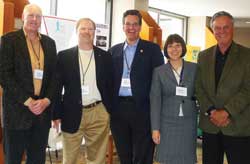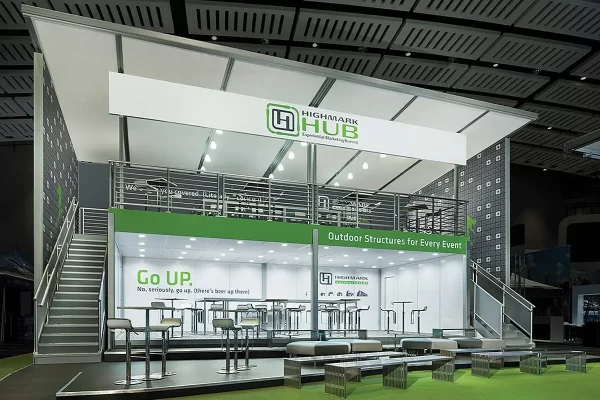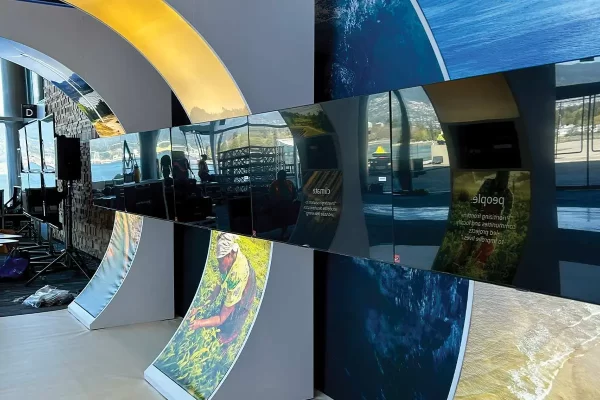In 2003, the incoming Exhibit Designers and Producers Association (EDPA) president, Norm Friedrich, stated “it’s time we put the ‘D’ back in EDPA.” Four years prior, the EDPA education committee worked with Bemidji State to offer real world coaching for their successful undergraduate degree program in exhibit design. The program remains successful to date. The committee also worked with the University of Nevada, Las Vegas to create a similar program, but never got off the ground.
At that time EDPA conducted a survey asking exhibit company owners, “What qualities do you look for when hiring an exhibit designer?” They wanted to be certain what was being formally taught included the skills needed for real world experiences. The answer was not the obvious. The ability to draw, exercise time management and be creative ranked second, third and fourth to their ability to communicate.
In 2003, FIT (Fashion Institute of Technology) implemented a master’s degree program in exhibition design. EDPA quickly responded to help provide input. They shared the survey results and determined that a course in storytelling would work nicely to develop communication skills. Other courses required ranged from graphic design to model making, lighting design to museum design.
The first graduating class in 2004 had nine students. The class of 2010 totaled 14 students.
“Providing and supporting reliable platforms for education in the exhibit industry is key to our continued success,” said Adam Beckett, of Derse Exhibits, who leads the current EDPA education committee.
All students are required to prepare a thesis presentation on a display challenge of their choice. The display can be a tradeshow, a museum gallery or a commercial store environment. Communicating the concept of their exhibit and its purpose is key to their final grade. Each student is then required to serve an eight-week internship with a display supplier to relate to the real work experiences awaiting them.
The student work at FIT was judged on May 17 by 23 industry experts as well as the teaching staff at FIT. The thesis presentation event is entitled “Capstone.”
Student presentation props ranged from color renderings to product samples, photography to video. Again, communicating the ideas ranked high for judges’ conclusions.
Thesis presentations required a full day. The day concluded with excellent food and keynote speaker James Damian, who changed the world of retail shopping environments. His success stemmed from his freedom to change the environments at Tiffany and Company, Best Buy and Buffalo Wild Wings.
Concluding presentations were made by Professor Brenda Cowan, director of the Exhibit Design program; Dr. Steven Zucker, dean of the graduate school at FIT; and Jeff Provost, director of EDPA.
“The pride on the faces of the students, their parents, FIT staff and our EDPA team spoke volumes for the programs success,” said Mark Johnson, CEO of Star Exhibits & Environments, and past president of EDPA.
Special thanks were extended to FIT Professor Brenda Cowan for her passionate commitment to excellence for both the program content, as well as her dedication to each of the students.
“One of the greatest challenges when teaching design on the graduate level is relevancy to the industry. Due in large part to our strong relationship with EDPA, we have the benefit of creating projects for actual firms where we can work with professional exhibit specifications and regulations, materials and production requirements,” Cowan said. “Likewise, we are given the opportunity to do client and subject research and develop narratives that truly impact audiences. EDPA has enabled us to make a strong
connection with our educational program and is continuing to help us build a strong future.”
Jon Horn, senior vice president of Creative-3D Exhibits, said he was continually impressed and inspired by the designers.
“It’s proof that the program provides an excellent foundation to launch the careers of new exhibition designers,” he added. “I’m most encouraged by the obvious passion the students have for environmental storytelling. The diversity of the topics chosen, the depth each designer dives to in creating their solutions and the variety of approach to the pitch are all very cool to experience. It’s exciting to hear and feel the desire and anticipation they have for working in a firm or institution…to get their shot at real world project opportunities and challenges.”
Through this program, EDPA has succeeded in putting the “D” back into EDPA as all the courses taught were recommended by EDPA professionals.
The insights taught to each of the 14 students will add value to the exhibit companies who choose to invest in their futures.
Highlights of students’ work include five projects that explore conceptual analysis, presentation, creation of appeal and marketing for new buyers.
Student Danae Colmer’s conceptual analysis, “Seeing through new eyes,” was a gallery presentation analysis using Pablo Picasso’s famous painting “Guernica.” She explored, “Seeing what the painter sees – or do you? The simplicity of the famous Nike logo evolved from many versions that needed explanation. Getting an audience to open the eyes of their imaginations is a marketing challenge that all idea weavers dream to achieve.”
Student Natallia Tsynkevich’s presentation was meant to gain attention and make a point: the plight of the polar bears and a zoo-like environment to simulate the bears’ natural habitat. Tsynkevich commissioned to have an ice sculpture of a polar bear brought into the class. By the end of the day, it melted to a different shape and eventually disappeared.
Student Nicole Radske created appeal beyond the main attendee with “Dress to the Nines,” a proposed extension to the Baseball Hall of Fame in Canton, Ohio. It included topics that appealed to the wives and children of the dads who brought them there on vacation. Attractions included uniform and equipment styles throughout the years as well as interactive games.
Student Amanda Zanski explored marketing for new buyers with “Summit Brewing Co. – Beyond Minnesota,” a plan to expand the reach of a local beer brewer to reach the east and west coasts, and included interior design brand, brewing appeal and regional pride.
Maria Saieh Guzman’s “Shopping Innovation!” brought a health food section to local grocery stores. The project created an in-store program that educated buyers about healthy eating and offered a free basket of food best suited for them in place of food stamps.































